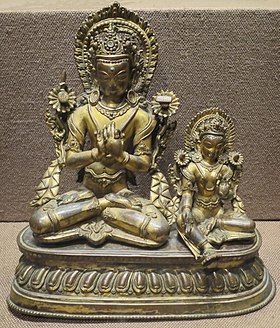
An asana is a body posture, used in both medieval hatha yoga and modern yoga.[1] The term is derived from the Sanskrit word for 'seat'. While many of the oldest mentioned asanas are indeed seated postures for meditation, asanas may be standing, seated, arm-balances, twists, inversions, forward bends, backbends, or reclining in prone or supine positions. The asanas have been given a variety of English names by competing schools of yoga.[2]
The traditional number of asanas is the symbolic 84, but different texts identify different selections, sometimes listing their names without describing them.[3][a] Some names have been given to different asanas over the centuries, and some asanas have been known by a variety of names, making tracing and the assignment of dates difficult.[5] For example, the name Muktasana is now given to a variant of Siddhasana with one foot in front of the other, but has also been used for Siddhasana and other cross-legged meditation poses.[6] As another example, the headstand is now known by the 20th century name Shirshasana, but an older name for the pose is Kapalasana.[3][7] Sometimes, the names have the same meaning, as with Bidalasana and Marjariasana, both meaning Cat Pose.[8][9]
- ^ Singleton 2010, pp. 4–5.
- ^ Murugan 2012.
- ^ a b Bühnemann, Gudrun (2007). Eighty-Four Asanas in Yoga: A Survey of Traditions. New Delhi: D. K. Printworld. pp. 47, 151. ISBN 978-8124604175.
- ^ Rosen, Richard (2017). Yoga FAQ: Almost Everything You Need to Know about Yoga-from Asanas to Yamas. Shambhala. pp. 171–. ISBN 978-0-8348-4057-7.
- ^ Sjoman 1999, p. 59.
- ^ "Muktasana". Yogapedia. Retrieved 23 November 2018.
- ^ Sjoman 1999, p. 57.
- ^ Lidell 1983, p. 166.
- ^ Cite error: The named reference
AkashaCatwas invoked but never defined (see the help page).
Cite error: There are <ref group=lower-alpha> tags or {{efn}} templates on this page, but the references will not show without a {{reflist|group=lower-alpha}} template or {{notelist}} template (see the help page).